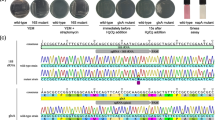Abstract
Bradyrhizobium japonicum strain TA-11NOD+, with altered indole biosynthesis, exhibited enhanced nodulation and nitrogen fixation on soybean in previous greenhouse studies. In this study, field experiments were conducted at Upper Marlboro, Maryland, in the summers of 1988 and 1993. In 1988, the site used was essentially free of soybean-nodulating bacteria and seed yield in plots inoculated with either I-110ARS or TA-11NOD+ was significantly higher by 12 or 20%, respectively, than that of the uninoculated controls. The 1993 site had an indigenous soil population (about 104 cells g-1) of symbiotically ineffective soybean-nodulating bacteria. Nevertheless, six-week-old ‘Morgan’ soybean plants inoculated with strain TA-11NOD+ had 44% more nodules and exhibited 50% more nitrogen fixation by acetylene reduction when compared with plants that received the parental strain I-110ARS. Nodule occupancy, as determined using genetic markers for rifampicin and streptomycin resistance, was significantly higher for strain TA-11NOD+ than for strain I-110ARS. Overall, for the two years and the two soybean genotypes, the yield obtained with TA-11NOD+ was 6% higher than that obtained with I-110ARS. Competition experiments were conducted in the greenhouse and strain TA-11NOD+ was significantly more competitive than strain I-110ARS in competition with strains USDA 6 or USDA 438.
Similar content being viewed by others
References
Bosworth A H, Williams M K, Albrecht K A, Kwiatkowski R, Beynon J, Hankiuson T R, Ronson C W, Cannon F, Wacek T J and Triplett E W 1994 Alfalfa yield response to inoulation with recombinant strains of Rhizobium meliloti with an extra copy of dctABD and/or modified nifA expression. Appl. Environ. Microbiol. 60, 3815–3832.
Dowling D N and Broughton W J 1986 Competition for nodulation of legumes. Annu. Rev. Microbiol. 40, 131–157.
Hunter W J and Kuykendall L D 1990 Enhanced nodulation and nitrogen fixation by a revertant of a nodulation-defective Bradyrhizobium japonicum tryptophan auxotroph. Appl. Environ. Microbiol. 56, 2399–2403.
Johnson H W, Means U M and Waber C R 1965 Competition for nodule sites between strains of Rhizobium japonicum applied as inoculum and strains in the soil. Agron. J. 57, 178–185.
Keyser H H and Cregan P B 1987 Nodulation and competition for nodulation of selected soybean genotypes among Bradyrhizobium japonicum serogroup 123 isolates. Appl. Environ. Microbiol. 53, 2631–2635.
Kummer R M and Kuykendall L D 1989 Symbiotic properties of amino acid auxotrophs of Bradyrhizobium japonicum. Soil Biol. Biochem. 21, 779–782.
Kuykendall L D 1987 Isolation and identification of genetically marked strains of nitrogen-fixing microsymbionts of soybeans. In Symbiotic Nitrogen Fixation Technology. Ed. G H Elkan. pp 205–220. Marcel Dekker, New York, USA.
Kuykendall L D and Hunter W J 1991 U. S. patent 5,021, 076.
Kuykendall L D and Hunter W J 1992 Altered tryptophan biosynthesis in Bradyrhizobium japonicum gives enhanced nodulation and nitrogen fixation. In Plant Biotechnology and Development. Ed. P M Gresshoff. pp 71–79. CRC Press, Ann Arbor, MI, USA.
Kuykendall L D and Hunter W J 1995 Symbiotic ineffectiveness of trpCD deletion mutants of Bradyrhizobium japonicum. Soil Biol. Biochem. 27, 1035–1039.
Kuykendall L D and Weber D F 1978 Genetically marked Rhizobium identifiable as inoculum strain in nodules of soybean plants grown in fields populated with Rhizobium japonicum. Appl. Environ. Microbiol. 36, 915–919.
Pinochet X, Arnaud F and Cleyet-Marel J C 1993 Competition for nodule occupancy of introduced Bradyrhizobium japonicum strain SMGS1 in French soils already containing Bradyrhizobium japonicum strain G49. Can. J. Microbiol. 39, 1022–1028.
Streeter J G 1994 Failure of inoculant rhizobia to overcome the dominance of indigenous strains for nodule formation. Can. J. Microbiol. 40, 513–522.
Triplett E W and Sadowsky M J 1992 Genetics of competition for nodulation of legumes. Annu. Rev. Microbiol. 46, 399–428.
Van Rhijn P and Vanderleyden J 1995 The Rhizobium-plant symbiosis. Microbiol. Rev. 59, 124–142.
Weaver R W and Frederick L R 1971 A new technique for most-probable-number of rhizobia. Plant and Soil 36, 219–222.
Zdor R E and Pueppke S G 1991 Nodulation competitiveness of Tn-5 induced mutants of Rhizobium fredii USDA 208 that are altered in motility and extracellular polysaccharide production. Can. J. Microbiol. 37, 52–58.
Author information
Authors and Affiliations
Rights and permissions
About this article
Cite this article
Kuykendall, L.D., Hashem, F.M. & Hunter, W.J. Enhanced competitiveness of a Bradyrhizobium japonicum mutant strain improved for nodulation and nitrogen fixation. Plant Soil 186, 121–125 (1996). https://doi.org/10.1007/BF00035065
Issue Date:
DOI: https://doi.org/10.1007/BF00035065




